Explore The Spiritual Landmark Al-Azhar Mosque In Cairo
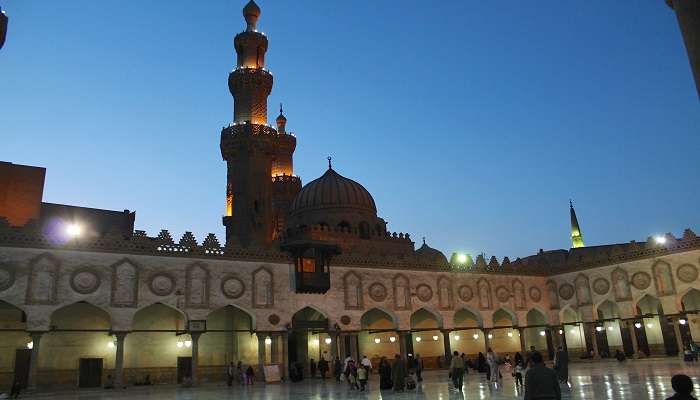
AI-Azhar Mosque in Islamic Cairo is a stunning building with tall minarets, a large courtyard, and intricate designs. It’s beautiful and a place of great importance for Islamic learning. Al-Azhar University, one of the oldest universities in the world, is located here. Scholars have studied here for centuries, making it a symbol of knowledge and history. Its imposing walls and detailed architectural details transport visitors back to the glorious eras of the Fatimid and Mamluk dynasties, whose rulers left an indelible mark on the splendour of this sacred site. It is revered as “the most prestigious university in the Sunni Muslim world.”
About Al-Azhar Mosque
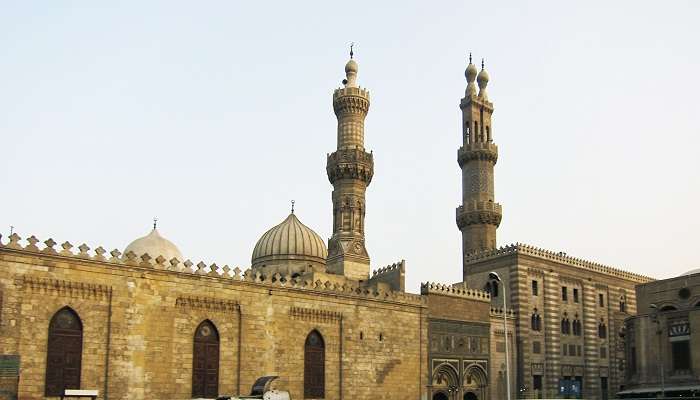
Al Azhar Mosque, originally established as a Shiite Ismaili institution, underwent significant changes under rulers. The Ayyubid dynasty diminished its importance due to its origins. However, during the Mamluk Sultanate era, the mosque saw expansions and renovations that restored its prominence.
Originally founded as a Shiite Ismaili institution, its importance changed due to different rulers. The Ayyubid dynasty downplayed its significance because of its Shiite roots. However, during the Mamluk Sultanate, the mosque underwent expansions and renovations, restoring its prominence.
Al-Azhar Mosque is closely linked to Al-Azhar University, one of the world’s oldest continuously operating universities. While initially part of the mosque, the university became independent in 1961 after the Egyptian Revolution. Al-Azhar University is renowned for its focus on Sunni theology and Islamic law. Despite its ups and downs, Al-Azhar Mosque remains a respected symbol of Islamic heritage. Its minarets stand tall in Cairo, reminding visitors of its enduring legacy.
Must Read: Mosques In Egypt
Al-Azhar Mosque History

One of the oldest and most significant mosques in Egypt and the Arab world, Al-Azhar Mosque has a rich historical background. Its cornerstone was laid on Ramadan 14, 359 AH (970 AD), during the opulent Fatimid dynasty. The mosque’s construction began during Ramadan in 361 AH (972 AD) under the order of Jawhar al-Saqli, the renowned leader who founded the city of Cairo. The mosque spans an impressive area of 12,000 square meters. It boasts over 380 beautiful marble columns, their crowns sourced from ancient Egyptian temples.
In 378 AH (988 CE), Caliph Al-Aziz Billah transformed Al-Azhar into a university, focusing on teaching the esoteric sciences of Ismailism to scholars from Africa and Asia. However, during the Ayyubid Dynasty’s rule in Egypt, Al-Azhar faced neglect after Salah al-Din al-Ayyubi overthrew the Fatimids in 1171. Salah al-Din was hostile toward the teachings propagated at Al-Azhar during the Fatimid Caliphate.
For nearly a century, prayer at Al-Azhar was interrupted as Salah al-Din invalidated the sermons at the mosque—a stronghold of the Ismaili Shiites. It wasn’t until December 17, 1267, during the reign of Al-Zahir Baybars, Sultan of Egypt, that Friday prayers were held again at Al-Azhar Mosque. Today, the mosque stands as an important cultural centre.
Architecture And Design Of Al-Azhar Mosque
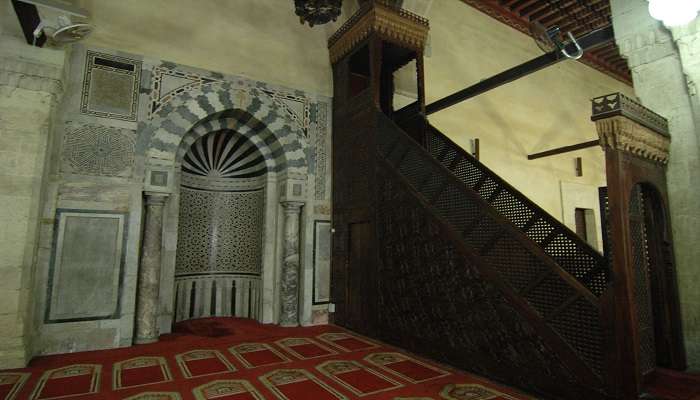
The Al Azhar mosque in Cairo stands out as a representation of Islamic architectural brilliance, blending influences from various historical eras and royal lineages. It boasts five minarets, each meticulously crafted with designs and heights symbolizing the core tenets of Islam. The mosque is also home to a dome sheltering the tomb of Fatimid caliph al Aziz, who passed away in 996 CE. Adorned with patterns and graceful calligraphy, the dome’s emerald hue signifies the reign of the Fatimid dynasty.
Surrounded by arcades and columns, the mosque’s spacious courtyard features a fountain for cleansing. Encircled by four gates named after prophets, each gate faces a direction. The primary entrance, Bab al Mu’izz, opens northward to the Cairos thoroughfare, named after the mosque’s founder. Other gates include Bab al Futuh, facing east towards Khan el Khalili bazaar; Bab al Nasr, facing west towards Saladin Citadel; and Bab al Zuweila, facing south towards Cairo city centre.
Inside, the mosque houses a vast prayer hall accommodating up to 20,000 worshippers. The hall features a mihrab, or niche, indicating the direction of Mecca and a minbar, or pulpit, from which the imam delivers sermons. A wooden screen divides the male and female sections. The hall is embellished with beautiful carpets, lamps, and chandeliers, and its walls are adorned with exquisite calligraphy and verses from the Quran.
Suggested Read: Things To Do In Cairo
Entrance Fees And Opening Hours
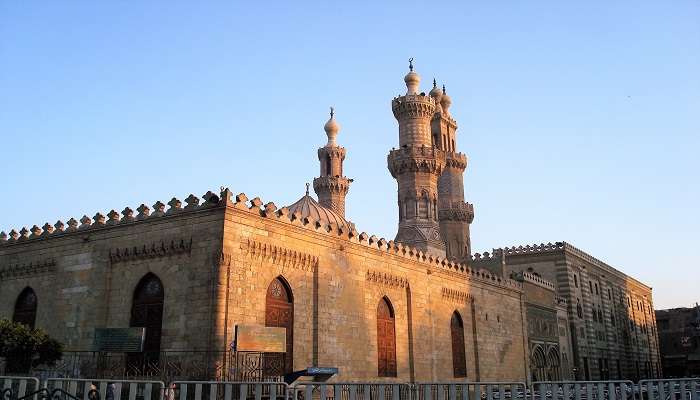
The Al Azhar mosque’s opening hours are daily from 9 a.m. to 5 p.m. (except on Fridays, when it’s closed for noon prayers).
Foreign visitors pay an entrance fee of 60 pounds ( $4), while locals pay 10 Egyptian pounds (approximately $0.6).
Best Time To Visit Al-Azhar Mosque

The best time to visit Al-Azhar Mosque is during Ramadan and winter, from November to March. The winter season offers pleasant weather, making it ideal for sightseeing. During Ramadan, the mosque exudes a festive atmosphere, and the nearby souks (markets) come alive with activities.
Suggested Read: Villas In Cairo
How To Reach Al-Azhar Mosque
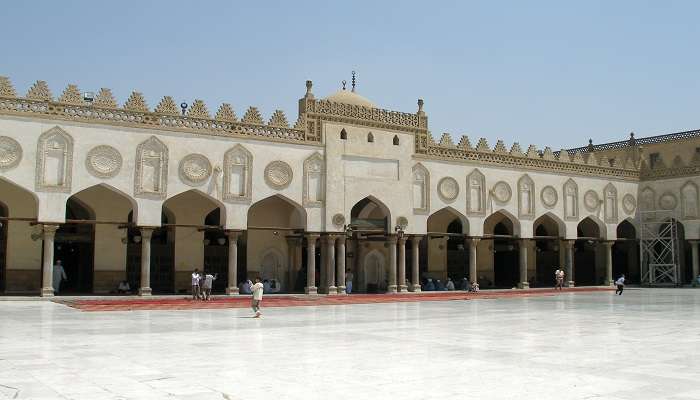
Al-Azhar Mosque, located in the heart of Cairo, Egypt, is easily accessible by various modes of transportation including public transport, cars, and taxis.
By Car
Al-Azhar Mosque is situated approximately 3 km from the city centre. The drive takes about 5 minutes via Kasr El Nile and Kobri Al Azhar.
By Bus
Al Mosky (Port Said St) is the nearest bus stop to the Al-Azhar Mosque. It is well-connected by several bus routes throughout Cairo. From the bus stop, it is a quick 13-minute walk to the mosque.
By Metro
The closest metro station to Al-Azhar Mosque is Ataba. From Ataba station, you can walk to the mosque in approximately 18 minutes along Kobri Al Azhar Street.
Further Read: Egypt In March
Exploring the ancient wonders of Cairo, including the majestic Al-Azhar Mosque, is an experience that should be on every traveller’s bucket list. Immerse yourself in this remarkable city’s captivating blend of history, architecture, and spirituality. Unlock the secrets of Egypt’s storied past and embrace its vibrant present by booking your unforgettable trip to Egypt today. Discover the timeless allure of Al-Azhar Mosque and let its grandeur leave an indelible mark on your soul.
For our editorial codes of conduct and copyright disclaimer, please click here.
Cover Image Credit: Aymanrefaat09 for Wikimedia Commons
Frequently Asked Questions About Al-Azhar Mosque
Why is the Al-Azhar Mosque important?
Al-Azhar Mosque is one of the earliest and most important mosques in Egypt and the Arab world. It is a source of wisdom and the largest religious institution in the Islamic world. Beyond its role as a place of worship, Al-Azhar has become an intellectual hub that shapes Islamic scholarship.
Who founded Al Azhar?
Al-Azhar Mosque was founded during the opulent Fatimid dynasty in Cairo. The Caliph al-Mu’izz laid its cornerstone in 970 AD. Initially, it served as a congregational mosque, but it quickly evolved into a centre for learning and scholarship.
How old is Azhar Mosque?
The history of Al-Azhar dates back to the Fatimid Era. The cornerstone was laid on Ramadan 14, 359 AH (971 AD). It took two years to complete the construction, and the mosque was named after Lady Fatima al-Zahra, to whom the Fatimids are attributed.
How to visit Al-Azhar Mosque?
To reach Al-Azhar Mosque in Cairo, Egypt, head to the city centre and take a taxi, ride-sharing service, or public transportation to the mosque's location in Islamic Cairo near Khan El Khalili bazaar.
What is Al Azhar known for?
Al-Azhar is renowned for its role in Islamic education and scholarship. In 988 CE, Caliph Al-Aziz Billah transformed it into a university, teaching esoteric sciences of Ismailism to scholars from Africa and Asia. It remains a symbol of knowledge and spiritual significance.
People Also Read:
Suleymaniye Mosque In Istanbul Sheikh Zayed Mosque Selimiye Mosque

Unveil the hidden treasures of the globe and turn every travel dream into reality. As a Content Writer, I am passionate enough to craft stories from ancient wonders to modern marvels. My words paint the picture-perfect itinerary for unforgettable experiences. Let my words be your trusted guide to immerse in the diverse culture and discover the beauty of the unknown.











